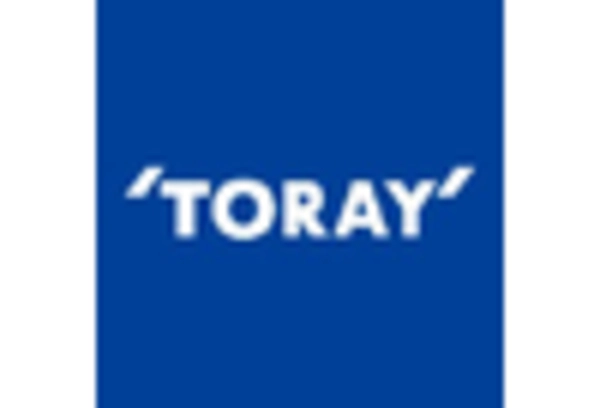Growing End-User Industries
The growth of end-user industries in APAC is significantly impacting the thermoplastic composites market. Sectors such as automotive, aerospace, and construction are increasingly adopting these materials due to their advantageous properties. For instance, the automotive industry is projected to grow at a CAGR of 8% from 2025 onwards, driven by the demand for lightweight and durable components. Similarly, the aerospace sector is expected to expand, with thermoplastic composites being utilized in aircraft structures to enhance performance and reduce weight. This broadening application base indicates a robust demand for thermoplastic composites, suggesting that the market in APAC will continue to thrive as these industries evolve and seek innovative solutions.
Increasing Investment in R&D
Increasing investment in research and development (R&D) is a pivotal driver for the thermoplastic composites market in APAC. Companies are allocating substantial resources to innovate and enhance the properties of thermoplastic composites, aiming to expand their applications. In 2025, it is projected that R&D expenditures in this sector will rise by approximately 25%, reflecting a commitment to developing high-performance materials that meet diverse industry needs. This focus on innovation is likely to yield new composite formulations with superior mechanical properties, thermal resistance, and processing capabilities. Consequently, the thermoplastic composites market in APAC is expected to benefit from a wave of new products and applications, further solidifying its position in various industries.
Government Regulations and Policies
Government regulations and policies in APAC are playing a crucial role in shaping the thermoplastic composites market. Various countries are implementing stringent environmental regulations aimed at reducing carbon footprints and promoting the use of sustainable materials. For instance, initiatives to limit greenhouse gas emissions are encouraging manufacturers to explore thermoplastic composites as viable alternatives to traditional materials. In 2025, it is anticipated that compliance with these regulations will drive a 15% increase in the adoption of thermoplastic composites across multiple industries. This regulatory landscape not only fosters innovation but also enhances the competitive edge of companies that invest in advanced composite technologies. Consequently, the thermoplastic composites market in APAC is likely to witness accelerated growth as businesses align their strategies with governmental sustainability goals.
Rising Demand for Lightweight Materials
The thermoplastic composites market in APAC is experiencing a notable surge in demand for lightweight materials, particularly in the automotive and aerospace sectors. As manufacturers strive to enhance fuel efficiency and reduce emissions, the adoption of thermoplastic composites is becoming increasingly prevalent. These materials offer a favorable strength-to-weight ratio, which is essential for meeting stringent regulatory standards. In 2025, the automotive sector is projected to account for approximately 30% of the thermoplastic composites market, driven by the need for lighter vehicles. Furthermore, the aerospace industry is also expected to contribute significantly, as airlines seek to lower operational costs through weight reduction. This trend indicates a robust growth trajectory for the thermoplastic composites market in APAC, as industries prioritize sustainability and performance.
Technological Innovations in Manufacturing
Technological innovations in manufacturing processes are significantly influencing the thermoplastic composites market in APAC. Advancements such as automated fiber placement and 3D printing are enhancing the efficiency and scalability of composite production. These technologies enable manufacturers to produce complex geometries with reduced waste, thereby lowering costs and improving product performance. In 2025, it is estimated that the integration of these technologies could lead to a 20% reduction in production costs for thermoplastic composites. This cost-effectiveness, combined with improved material properties, is likely to attract a broader range of applications across various sectors, including construction and consumer goods. As a result, the thermoplastic composites market in APAC is poised for substantial growth, driven by the continuous evolution of manufacturing technologies.


















Leave a Comment